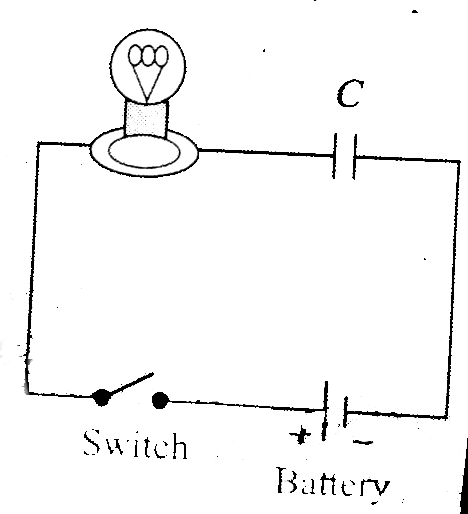What will happen if the post - synaptic receptors in a chemical synapse are removed ?
(a) Synaptic transmission will be faster
(b) Synaptic transmission will become slower
(c ) Synaptic transmission will be not occur
(d) Synaptic transmission will be unaffected
Chemical synaptic transmission will not occur. This is because if receptors on the post - synaptic membrane will be removed, the neurotransmitters released from the pre - synaptic neuron will not be able to bind anywhere on the post - synaptic membrane. The action potential will not develop in the post - synaptic neuron. Hence, synaptic transmission will not occur across a chemical synapse.
Topper's Solved these Questions
- BOOK - AAKASH INSTITUTE ENGLISHCHAPTER - NEURAL CONTROL AND COORDINATION EXERCISE - Try Yourself26videos
NEURAL CONTROL AND COORDINATION
- BOOK - AAKASH INSTITUTE ENGLISHCHAPTER - NEURAL CONTROL AND COORDINATION EXERCISE - EXERCISE50videos
NEURAL CONTROL AND COORDINATION
- BOOK - AAKASH INSTITUTE ENGLISHCHAPTER - MORPHOLOGY OF FLOWERING PLANTSEXERCISE - TRY YOURSELF38videos
MORPHOLOGY OF FLOWERING PLANTS
- BOOK - AAKASH INSTITUTE ENGLISHCHAPTER - ORGANISMS AND POPULATIONS EXERCISE - ASSIGNMENT (SECTION-D) (Assertion-Reason Type Questions)15videos
ORGANISMS AND POPULATIONS
Similar Questions
Knowledge Check
- Question 1 - Select One
A list of events occurring in the transmission of nerve impulse across the synapse is given below in a random order
(i)Opening of specific ion channels allows the entry of ions, a new action potential is generated in the post-synaptic neuron.
(ii)Neurotransmitter binds to the receptor on post synaptic membrane.
(iii)Synaptic vesicle fuses with pre-synaptic membrane, neurotransmitter release into synaptic cleft.
(iv)Depolarisation of pre-synaptic membrane.
(v)Arrival of action potential at axon terminal.
Which of the following options represents these events in a correct order ?A(v)→(iv)→(iii)→(ii)→(i)B(i)→(ii)→(iii)→(iv)→(v)C(i)→(ii)→(iv)→(iii)→(v)D(v)→(iv)→(iii)→(i)→(ii) - Question 2 - Select One
Assertion:Electrical synapses are rare in our system.
Reason:Impulse transmission across an electrical synapse is slower than that across a chemical synapse.AIf both assertion and reason are true and reason is the correct explanation of assertion.BIf both assertion and reason are true but reason is not the correct explanation of assertion.CIf assertion is true but reason is false.DIf both assertion and reason are false. - Question 3 - Select One
Which of the following statements is/are incorrect about the electrical synapse ?
(i)At electrical synapses, the membranes of pre and post synaptic neurons are in very close proximity.
(ii)Electricity current can flow directly from one neuron into the other across the synapses.
(iii)Transmission of an inpulse across electrical synapses is very similar to impulse conduction along single axon.
(iv)Electrical synapses pass electrical signal between cells with the use of Ach.
(v)Electrical synapses are fast.
(vi)Electrical synapses are rare in our system.A(ii),(iv) and (v)B(i) and (iii)C(iv) onlyD(i),(v) and (vi)
Once a synaptic junction between neurons has allowed transmission of a nerve impulse, it is made ready to transmit next impulse by the action of
View Solutionin electrical synapse, impulse from presynaptic membrane reaches post-synaptic membrane through
View SolutionDuring synaptic transmission of nerve impulse, neurotransmitter (p) is released from synaptic vesicles by the action of ions (Q). Choose the correct P and Q
View SolutionWhen is the higher rate of energy being delivered to a light bulb higher : just after it is turned on, the glow of the filament is increasing, or after it has been on for a few seconds and the glow is steady ?
 View Solution
View SolutionThe given diagram shows axon terminal.Select the option that correctly matches the steps in transmission of impulses (list i-vii) with the labellings (A-C) in diagram.

(i)Chemicals called neurotransmitters are released in the synaptic cleft through ion channels.
(ii)When an impulse arrives at the axon terminal, it stimulates the movement of synaptic vesicles.
(iii)Neurotransmitters are endocytosed into the neurons.
(iv)The ions channels close with the binding of neurotransmitters to their specific receptors vesicles.
(v)Synaptic vesicles move towards the membrane where they fuse with the plasma membrane.
(vi)Neurotransmitters are released in the synaptic cleft.
(vii)The released transmitters bind to their specific receptors on post-synaptic membraneView Solution

